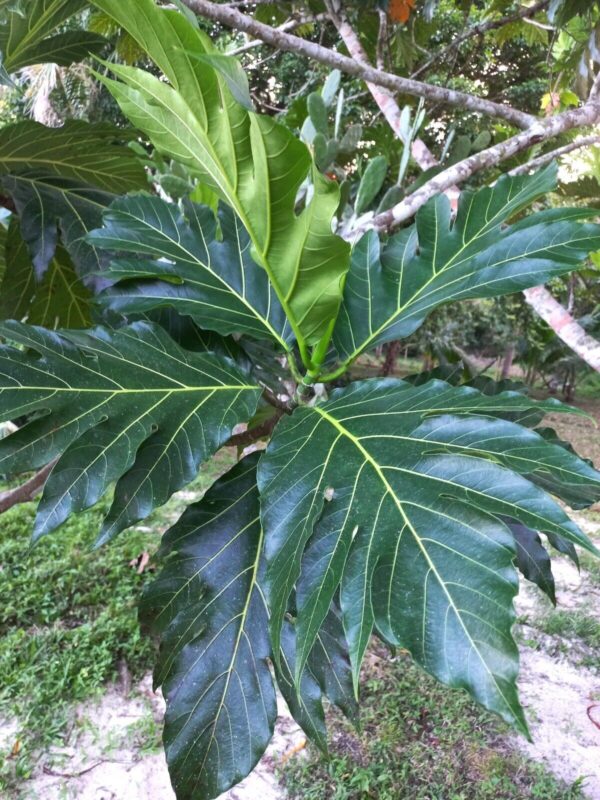Blog
Major Health Benefits of Breadfruit Leaves: Nature’s Nutritional Powerhouse
Breadfruit (Artocarpus altilis) is a tropical fruit tree native to the Indo-Malay region and widely cultivated in many tropical regions worldwide. While the fruit itself is often celebrated for its culinary versatility and nutritional benefits, the leaves of the breadfruit tree are equally remarkable and have been used in traditional medicine for centuries. Rich in essential nutrients and bioactive compounds, breadfruit leaves offer a range of health benefits that can enhance overall well-being. In this article, we will explore the medicinal properties, health benefits, and traditional uses of breadfruit leaves, highlighting their significance as a natural remedy.
Phytochemical Composition
The health benefits of breadfruit leaves can be attributed to their rich phytochemical composition. Key components include:
- Vitamins and Minerals: Breadfruit leaves are abundant in vitamins A, C, and several B vitamins, along with essential minerals like calcium, potassium, and magnesium.
- Flavonoids: These powerful antioxidants help combat oxidative stress and reduce inflammation in the body.
- Tannins: Known for their astringent properties, tannins can aid in wound healing and digestive health.
- Saponins: These compounds exhibit antimicrobial properties and may enhance immune function.
The combination of these nutrients makes leaves a valuable addition to a healthy diet.

Health Benefits
1. Antioxidant Properties
leaves are rich in antioxidants that help neutralize free radicals in the body. By reducing oxidative stress, these antioxidants may lower the risk of chronic diseases such as heart disease, diabetes, and cancer. Regular consumption of leaf tea or extracts can support overall health by promoting cellular integrity.
2. Anti-inflammatory Effects
The anti-inflammatory properties of leaves can help alleviate symptoms associated with various inflammatory conditions. By inhibiting pro-inflammatory cytokines, these leaves may provide relief from pain and swelling related to arthritis, asthma, and other inflammatory disorders.
3. Digestive Health
Traditionally, leaves have been used to treat digestive issues such as diarrhea and dysentery. The astringent properties of tannins can help regulate bowel movements and soothe gastrointestinal discomfort. Additionally, their antimicrobial effects can combat harmful bacteria in the gut, promoting a healthy digestive system.
4. Blood Sugar Regulation
Emerging research suggests that leaves may help regulate blood sugar levels. The presence of flavonoids and other bioactive compounds can improve insulin sensitivity and glucose metabolism, making them beneficial for individuals with diabetes or those at risk of developing the condition.
5. Immune System Support
The antimicrobial properties of leaves can enhance immune function by fighting off infections caused by bacteria and fungi. Regular consumption may help strengthen the body’s defenses against common illnesses.
6. Skin Health
Breadfruit leaves have been traditionally used in topical applications to treat skin conditions such as wounds, rashes, and infections. Their anti-inflammatory and antimicrobial properties make them effective for promoting skin healing and reducing irritation.

Traditional Uses
In various cultures, breadfruit leaves have been utilized for their medicinal properties:
- Wound Healing: The sap from the leaves is often applied to cuts and abrasions to promote healing.
- Fever Reduction: Infusions made from breadfruit leaves are traditionally consumed to help reduce fever.
- Respiratory Health: The leaves are sometimes used in herbal remedies to alleviate symptoms of respiratory conditions such as coughs and bronchitis.
How to Use Breadfruit Leaves
Breadfruit leaves can be consumed or applied in various forms:
- Infusions: Dried or fresh leaves can be steeped in hot water to create herbal teas that harness their health benefits.
- Powdered Form: The dried leaves can be ground into powder and added to smoothies or food for an added nutritional boost.
- Topical Applications: Extracts or infusions can be applied directly to the skin for wound healing or skin irritation relief.
Precautions
While breadfruit leaves are generally considered safe when used appropriately, it’s essential to consult with a healthcare provider before incorporating any new herbal remedies into your routine—especially if you are pregnant, nursing, or taking medications.
Conclusion
Breadfruit leaves are a remarkable natural remedy with a long history of use in traditional medicine. From their antioxidant properties to their ability to support digestive health and boost immunity, these leaves offer a wealth of health advantages that deserve recognition.As interest grows in natural remedies for maintaining health, incorporating breadfruit leaves into your wellness routine could provide significant benefits. Whether enjoyed as a tea or applied topically for skin benefits, this powerful herb deserves a place in your holistic health practices.By understanding the myriad benefits of breadfruit leaves and sharing this knowledge, we can promote natural healing practices that honor both tradition and modern science. Embrace the power of nature with this incredible plant and unlock its potential for enhancing your well-being today!

Discover more from Nath Mart
Subscribe to get the latest posts sent to your email.
